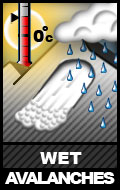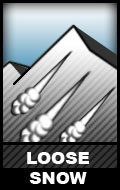Advisory based on observational knowledge and weather forecast available at time of posting (12am). Accuracy is subject to temporal and spatial variability and expires in 24 hours. Read the disclaimer and conduct your own assessment of conditions accordingly.
Thursday:
What you need to know:
While the avalanche danger is moderate, current snow conditions still demand careful evaluation in order to determine the specific avalanche concerns and danger level in the area in which you’re traveling. Dangerous avalanches conditions may still exist in certain areas, especially upper elevation wind loaded southerly aspects and later in the day on slopes receiving the most solar radiation and warming (south to west aspects).
Danger trend:
Increasing through the day on warming, sun-exposed slopes. The wind slab danger should be decreasing, but may increase if northerly winds ramp up again.
Avalanche Concerns:
Northerly winds were moving snow Wednesday afternoon mainly loading leeward southerly aspects as evidenced by localized pluming of dry snow in the upper elevations. A small human triggered wind slab was reported Wednesday that occurred near Ptarmigan Peak on an upper elevation southerly aspect. Expect more small, localized wind slabs on predominantly upper elevation southerly aspects to be reactive to human triggering.
Expect the danger to be the highest on south to west aspects later in the day (late afternoon to early evening).
If daytime temperatures continue to rise as forecast, human triggered wet loose avalanches (sluffing) may be an issue to contend with on steep, warmed, and moistened slopes. This type of sluffing snow will be relatively heavy and wet (packing more punch).
Human triggered sluffing is also likely on steep north facing terrain, but this snow will pack little punch due to it being light and dry snow.
Travel Advice:
In assessing the wind slab concern, be on the lookout for some of the typical characteristics like a rounded, pillowy look and/or hollow, slabby feel. A shooting crack in wind affected snow is a bull’s eye clue to wind slab instability.
Pay attention to the sun’s effect on the slopes. Look for rollerballs, point releases, sun induced sluffs, and other signs that the sun is significantly warming and decreasing stability on exposed slopes. When temperatures warm and solar radiation increases significantly, the wet avalanche danger will increase.
As always, be on the lookout for red flags of instability like recent avalanches, shooting cracks, collapsing or whumphing. What do these signs tell you about the stability in the area through which you’re traveling and how should you adjust your plans accordingly?
Mountain Weather for Thursday:
Mostly Sunny
Trailhead (2,000ft): Temps 10-33 degrees, winds NE 10mph
Upper Elevations (4,000ft): Temps around 20 degrees, winds < 10 mph




